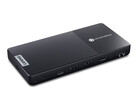I ditched my Windows laptop for a Chromebook a few years ago, a decision I haven’t regretted ever since. It has been a wonderful experience so far considering Chrome OS is practically still a new OS compared to Windows and macOS. Despite its newness, Chrome OS has gained several features over the past few years, and here are some pretty useful ones you may or may not know about.
Are you a techie who knows how to write? Then join our Team! Wanted:
- News Writer
Details here
1. Smart Lock
Modern Chromebooks come with a feature called Phone Hub that lets you pair your Android phone to your computer. Setting up the feature is straightforward. Open your Chromebook’s Settings app and select Connected devices on the left side of the pane. Follow the instructions and you should be good to go. Once your phone connects successfully, a handful of features become available, one of which is Smart Lock. This feature allows you to unlock your Chromebook with your phone. It is a convenient way to unlock your computer when in a public place or if someone is looking over your shoulder when you try to enter your password.
To use Smart Lock, Bluetooth has to be turned on on both your phone and computer. So if you usually turn Bluetooth off on either device, you have to leave it on. Your phone also has to be close to your Chromebook. Once both conditions are met, simply unlock your phone via whatever method you use (fingerprint, face unlock, password, or PIN), and your Chromebook will unlock, too.
2. App Streaming
App Streaming is another feature available if your phone is connected to your Chromebook. This feature allows you to stream several of your phone’s apps on your Chromebook such as WhatsApp, X, Discord, Messages, and even the Clock app, to name a few. Some apps that won’t stream include the Phone, Camera, Authenticator, etc. When you open a supported app, you can interact with it just as you’d do on your phone using your mouse or fingertips if your Chromebook has a touchscreen. In addition, you can type out replies with your Chromebook’s keyboard for messaging apps.
The advantage this feature brings is that you don’t have to pick up your phone to reply that message or check your Instagram feed. Like Smart Lock, Bluetooth has to be turned on on both devices to use App Streaming. They also have to be connected to the same Wi-Fi network. Once both conditions are met, click on the phone icon at the bottom left of the screen. Your most recent apps should be visible. Click on any of them or the collection of app icons to choose an app from the list of apps on your phone. The selected app will open in a small window on the right side of the screen. You can minimize the window and the app icon will be visible at the bottom of the screen. You can also click the phone icon next to the app icon to open another app. However, you can only open one app at a time.
3. Instant Tethering
While there are Chromebooks with LTE, most models such as the Asus Chromebook CM14 (curr. $209 on Amazon) don’t have LTE. However, with Instant Tethering and your connected Android smartphone, you can easily connect to the internet when away from a Wi-Fi network. The feature lets users connect to the internet through their phone, and while it might sound like you’re just using the Hotspot feature available on smartphones, it is simpler.
To use Instant Tethering, turn on mobile data on your phone and toggle the mobile data switch on your Chromebook Network settings. Your phone should appear under the toggle. Click on it, and your Chromebook will connect to the internet via your phone. When connected, a network signal icon will appear in place of a Wi-Fi network icon at the bottom of the screen.
4. Desks (Multiple Desktops)
Like Windows, Chrome OS also has support for multiple desktops, and this feature is called Desks. It is a neat way to organize your desktop such as separating work and play or different work projects. To create another desktop on Chrome OS, press the Show windows key (the function key with a rectangle and two lines on the right), and click on the pill-shaped plus button. You can give this desk a name but you can’t give it a separate wallpaper like you can on Windows. However, Chrome OS lets you save a desk for later, merge multiple desks, and move tabs or windows from one desk to another.
You can switch between desks by doing a four-finger swipe on the trackpad, pressing the Search or Launcher Key + left or right square bracket, or simply clicking the pill-shaped button on the shelf.


 Deutsch
Deutsch English
English Español
Español Français
Français Italiano
Italiano Nederlands
Nederlands Polski
Polski Português
Português Русский
Русский Türkçe
Türkçe Svenska
Svenska Chinese
Chinese Magyar
Magyar







